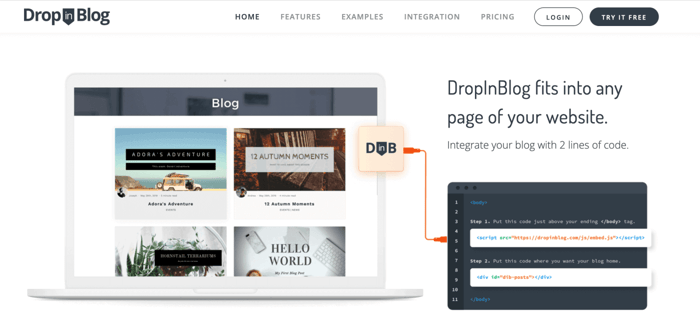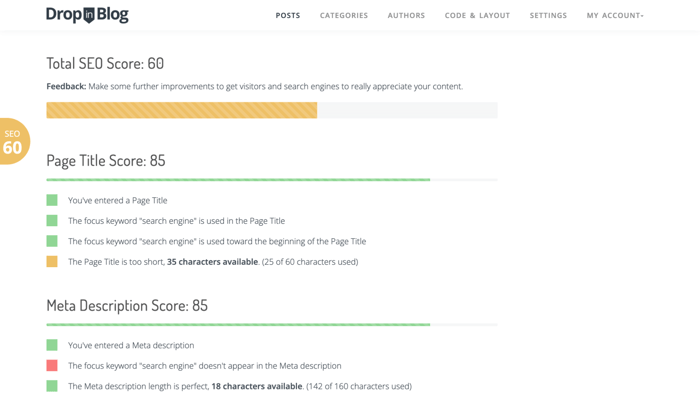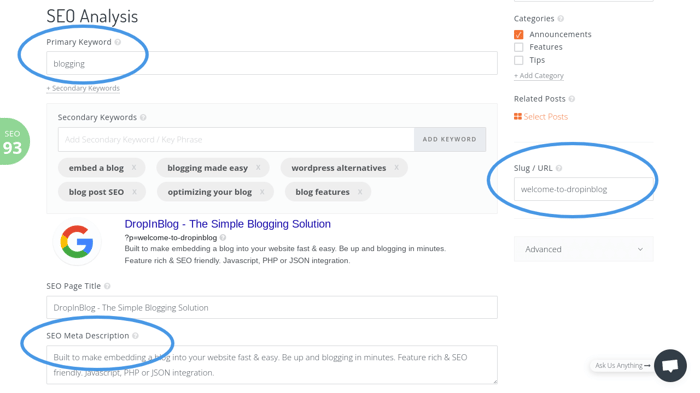As a blogger, you’re surely aware of the benefits of SEO, but if not, we’ve got all the details you need to know. We will elaborate on what SEO is, why it is important – especially for bloggers – and how to optimize your blog and blog posts for SEO. So, SEO for bloggers – let’s get down to it!
Table of Contents
- What Is SEO for Bloggers?
- Why SEO Matters for Blog Growth
- Using DropInBlog for SEO
- How to Optimize Your Blog Posts for SEO (In 10 Easy Steps)
- Step 1: Research Blogging Keywords
- Step 2. Write Your Own Meta Title and Meta Description
- Step 3. Organize Your Keywords Into a Clear Content Structure
- Step 4: Optimize Your Titles and Headings
- Step 5: Optimize Your URLs
- Step 6: Improve Readability and Flow
- Step 7: Use Internal and External Links to Build Structure
- Step 8: Include a Variety of Media
- Step 9: Make Sure Your Content Works on Mobile
- Step 10: Implement Schema Markup
- Common Mistakes Bloggers Make
- FAQs
- Final Thoughts
What Is SEO for Bloggers?
SEO for bloggers refers to all the techniques that help your blog posts rank higher in search engines like Google. It involves choosing the right keywords, formatting your content strategically, improving readability, optimizing images, and ensuring your content answers search intent better than competing posts.
You don’t need complicated tools or technical knowledge, just consistent, intentional optimization.
Why SEO Matters for Blog Growth
Organic traffic from search engines is often the most valuable, directing new visitors to your site so that you can begin to engage with them. Whether you run a personal blog, a niche site, or a content-heavy business, SEO helps you:
Drive consistent, passive traffic
Rank for topics your audience cares about
Build authority in your niche
Reduce reliance on social media algorithms
A blog that ranks well in search engine results pages (SERPs) also gains authority and presents itself as a credible source. When done well, SEO turns blogging into a sustainable long-term growth engine.
Using DropInBlog for SEO
Bloggers today have a bountiful range of choices when it comes to blogging platforms to use. One such platform that’s perfect for the job is DropInBlog. DropInBlog is platform-agnostic and works by integrating with whichever platform you host your website on.
Develop and manage all your blog posts from the DropInBlog dashboard, and when you publish, they’ll instantly go live on your website.

DropInBlog is optimized for SEO success right out of the box. Schema markup is automatically applied to your posts, and because of how it’s designed, it’s lightweight and won’t negatively affect page loading speeds. You can edit your URLs and meta title, as well as write your own meta description. It’s even possible to add social sharing buttons to help your blog posts reach a wider audience.

Best of all, DropInBlog includes a built-in SEO Analyzer, which assesses your content as you type. It then provides you with suggestions so you can optimize your content perfectly. By using this tool, you can test your content before you publish it and be sure it’s going to make the grade.

How to Optimize Your Blog Posts for SEO (In 10 Easy Steps)
Optimizing your blog for search engines requires making the structure easily readable, the site fast-loading, and ensuring your blog contains unique information that is helpful to the reader. You need to consider both on-page SEO and technical SEO.
Below is a detailed, practical process bloggers can follow for any new or existing post.
Step 1: Research Blogging Keywords
Keywords are the specific words or phrases used to match a user's search intent, and they’re an essential element of blog SEO. We recommend you carefully research the keywords to use in your blog posts, and there are a number of free and paid tools you can use to do this.
How to choose blogging keywords:
Use tools like Google Keyword Planner, Ahrefs, SEMrush, or even Google autocomplete.
Choose a primary keyword and 5–10 related terms.
Look for keywords with medium competition and clear intent.
Ideally, you want keywords with a fairly high search volume but low competition. Of course, that isn’t always possible, so it’s about finding the right combination.
Example (for a travel blog post):
Primary keyword: best places to travel solo
Supporting keywords: solo travel destinations, traveling alone tips, best cities for solo travelers
Step 2. Write Your Own Meta Title and Meta Description
Your meta title and description often act as your first impression in Google results. Writing these manually gives you control over how your post appears and improves your click-through rate.
Your meta title should include your primary keyword, stay under 60 characters, and reflect the actual content of the post. Think of it as a promise: what will someone get if they click?
Your meta description expands on that promise. Keep it under 160 characters, and use it to reinforce your post’s value. This is a chance to pull in readers with clarity and intent. A well-written meta description won’t directly improve your ranking, but it can absolutely improve your click-through rate, which matters just as much.
Step 3. Organize Your Keywords Into a Clear Content Structure
Once you’ve collected the right keywords, the next step is weaving them into your blog post in a way that's natural and helpful. You should organize your keywords so each one has a meaningful place in the article.
Primary keyword: Use it in your title, URL, H1, first paragraph, at least one subheading, and sprinkled naturally throughout the content.
Secondary/supporting keywords: These fit well into H2s and H3s, FAQ sections, bullet lists, and image alt text.
The goal isn’t to “stuff” keywords, it’s to make sure your content matches the language people use when they search for answers. When your headings and subheadings align with query phrasing, Google more easily understands what your content covers and is more likely to rank it.
Step 4: Optimize Your Titles and Headings
Think of your headings as the roadmap for your article. Clear headings make your content easier to navigate and encourage readers to continue scrolling. This is a signal to Google that your post is valuable.
Tips for effective headings:
Break large topics into logical sections
Use descriptive, helpful language
Include keyword variations naturally
Ensure each heading answers a question someone might search
Example: Instead of “Optimize Your Images,” try “How to Optimize Images for SEO (Filenames, Alt Text & More).” This tells both readers and search engines exactly what to expect.
Using power words, which are words that evoke emotion or action, is proven to be effective in titles.
Step 5: Optimize Your URLs
A clean URL reinforces what your post is about and helps search engines categorize it accurately. Aim for simplicity and clarity.
A good URL:
Includes your main keyword
Uses hyphens instead of underscores
Avoids unnecessary numbers or filler words
Stays short and readable
Example: /blog/best-solo-travel-places
However, not all website builders give you the ability to edit your URLs. Luckily, DropInBlog does, and you can see some of the many fields you can edit in the image below.

Step 6: Improve Readability and Flow
Most blog readers skim before deciding to commit. The easier your article is to read, the longer visitors stay, which indirectly helps your rankings.
You can make your content more engaging by using:
Short paragraphs
Bulleted or numbered lists
Examples and mini walkthroughs
Screenshots or visuals
Occasional bold text for emphasis
A well-formatted post is more likely to be read, shared, and linked to, all of which boost SEO.
Step 7: Use Internal and External Links to Build Structure
One of the most overlooked SEO tools is internal linking. Linking to other relevant posts within your site helps readers go deeper, keeps them on your site longer, and signals topical relevance to Google. You’re not just pointing them to more reading, you’re building a content network that supports itself.
When possible, link naturally from anchor text that reflects the topic of the post you’re linking to. But avoid phrases like “click here,” and instead use descriptive language that reflects what the reader can expect next.
Some bloggers are reluctant to send readers away from their site. But external links add value when they point to high-quality, relevant sources. They show that your content is connected to a broader conversation and backed by real research or authority.
Use them to cite studies, tools, or official documentation. As long as they’re useful and intentional, external links only strengthen your post.
Step 8: Include a Variety of Media
Text-heavy posts can become overwhelming, especially on mobile. Adding media breaks things up and supports different learning styles. Screenshots, charts, diagrams, or quick explainer videos can all enhance your content without distracting from it.
If you’re walking someone through a process, show what that process looks like. If you’re explaining a concept, visualize it. The goal is not just to add visual interest, but to support the content in a meaningful way.
Make sure images are compressed and always include alt text. Image alt text explains what’s in the image and helps search engines link the images in your blog to search queries.
Step 9: Make Sure Your Content Works on Mobile
Nearly 55% of internet users today browse the web from their phones. Making sure your site is responsive and mobile-friendly gives you many benefits. If your post loads slowly, breaks layout, or uses tiny fonts and hard-to-tap buttons, you’re going to lose traffic fast.
Mobile optimization starts with your theme, but it also includes:
Using large, legible fonts
Keeping paragraphs short
Ensuring images scale properly
Reducing unnecessary scripts or heavy embeds
Testing layout across device sizes
SEO isn’t just about keywords, it’s about usability. And mobile usability is non-negotiable.
Step 10: Implement Schema Markup
Schema markup is a simplified code that is easy for search engines to read. It helps search engines characterize different types of content on the page. This is yet another example of making your content easy to crawl and understand, but a very useful one. With schema markup, search engines will also display your data in rich snippets.
Data like ratings, reviews, images, and prices will be displayed on SERPs. It’s also more likely that your content will appear in the frequently asked questions accordion, which is yet another way for your blog to be found online.
Common Mistakes Bloggers Make
Even experienced bloggers slip up when it comes to SEO, and most of the time, the issue isn’t effort; it’s awareness. A few small missteps can quietly hold your posts back from ranking well or reaching their full traffic potential.
Here are some of the most common SEO mistakes bloggers make, and how to avoid them:
Skipping keyword research: Writing before checking what people are actually searching for means you risk creating great content that no one ever finds.
Writing without matching search intent: Your post might be well-written, but if it doesn’t clearly answer a question or solve a problem, it’s unlikely to rank.
Neglecting meta titles and descriptions: Leaving them blank or relying on auto-generated snippets means you lose control of how your content appears in results.
Not linking to other posts: Without internal links, your content becomes a collection of isolated pages, harder for readers (and Google) to navigate.
Overusing or stuffing keywords: Repeating keywords too often hurts readability and can trigger spam signals. Natural use always works better.
Publishing once and never updating: Outdated posts can slide down the rankings. Refreshing content with new info or targeting new queries can revive it.
Ignoring mobile experience: Slow load times, awkward layouts, or unreadable fonts on mobile are a fast way to lose readers and search visibility.
Not reviewing analytics or Search Console: If you’re not watching how your posts are performing, you miss chances to optimize based on real search data.
Avoiding these mistakes doesn’t require more effort, just better focus. Even small fixes can compound over time into stronger rankings, more consistent traffic, and a healthier blog overall.
SEO Mistakes to Avoid (Quick Checklist)
☐ Did I do keyword research before writing?
☐ Am I addressing clear search intent?
☐ Did I write a custom meta title and meta description?
☐ Have I linked to other relevant blog posts internally?
☐ Am I using keywords naturally, not stuffing them?
☐ Have I reviewed or refreshed this post over time?
☐ Is the post mobile-friendly and fast-loading?
☐ Have I checked Search Console or analytics for performance data?
Even checking off half of these can give an underperforming post a second life.
FAQs
How do I optimize a blog post for SEO?
Start with keyword research, then structure your post around what readers are actually looking for. Use your primary keyword in key places like the title, intro, URL, and headings, and make sure the post is easy to read, mobile-friendly, and supported by helpful visuals or internal links.
What are blogging keywords?
Blogging keywords are search terms your audience uses to find content like yours. They can be short phrases or specific questions, and they should guide both what you write and how you structure it, from titles and headings to FAQs and image alt text.
How many keywords should I use in a blog post?
You don’t need to overload your content with keywords. Focus on one main keyword, and include a few relevant variations where they fit naturally. The goal is to make the topic clear, not to repeat the same phrase over and over.
How should I name images for SEO?
Use clear, descriptive filenames (like seo-checklist-bloggers.jpg) instead of default names like IMG_1234.jpg. Add concise alt text that explains what the image shows and how it supports your content. This helps with accessibility and gives search engines more context.
Do I need to update old blog posts for SEO?
Yes. Even small updates, like refreshing examples, adding internal links, or including new keywords, can help older posts regain rankings. If a post is still relevant but traffic is dropping, that’s a strong signal that it’s time for a refresh.
Final Thoughts
SEO doesn’t need to be complicated. At the end of the day, it’s about helping your content get discovered by the people who are already searching for it. When you take time to structure your posts well, match search intent, and build in the right optimizations, you give each blog post a better chance at long-term visibility and traffic.
DropInBlog makes many of the steps in this post easy to implement. From editable meta titles and descriptions to schema markup and clean, readable URLs, DropInBlog supports SEO best practices right out of the box – so you can focus on content, not configuration.
Not every platform gives you full control over SEO essentials. If you find yourself limited by your current setup, you might consider migrating to DropInBlog. If you have any questions about how DropInBlog can help your blog succeed, feel free to reach out to the team.





